
 | Click on a place name to go to the story for that place (If it has been written). Otherwise just continue chronologically through the pages of the holiday story. (Clicking on Istanbul will takew you to our experiences in Istanbul at the end of the tour--but you are in Istanbul right now, at the start of the tour. |
In the previous page, we had just boarded a Turkish Airlines plane at Athens airport. After our experiences with both the planes and the precision(!) of Olympic Airways, we were prepared for anything. Olympic's final error had given us business class seating on the Turkish plane, but it is fair to say that even had that not happened, we would have been favorably impressed by the quality of the plane and of the service. It was a good harbinger of what was to come.
A word on spellings of Turkish words. Turkish has letters that do not exist in English, and are not available in the standard HTML character set. In particular, there is an s with a dot under it, pronounced "sh", and a c with a dot under it, pronounced "ch". In what follows, I may be inconsistent, but I will try to write these two as "s." and "c." With this convention, our guide in Turkey was Ahmet Is.c.imen, a trained archaelogist. There are also two "i" characters, one with a dot and one without. They sound quite different, but I will not try to make that distinction in this writing.
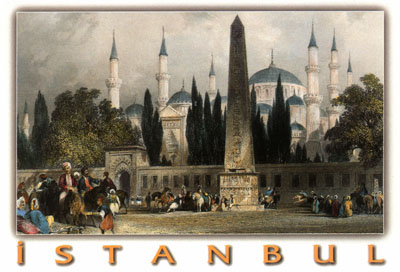 |
| A postcard impression of the Blue Mosque and
an Egyptian Obelisk from the time of Cleopatra in the Hippodrome. |
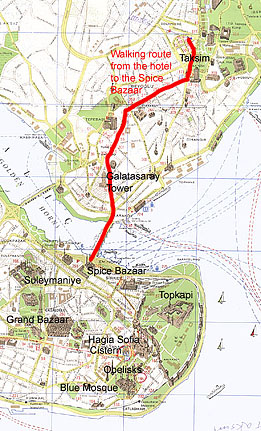 |
| The central part of Istanbul. The old city to the south of the Golden Horn, the new city to the north. Asia is just off the map to the east, across the Bosphorus. The water south of the old city is the Sea of Marmara. (Larger Map) |
A word about preconceptions. As most people do, we had some preconceptions and concerns about what we might find in Turkey. An Islamic country might not permit alcohol, a relatively poor country might not be friendly to Westerners and we might find many things not working, a country with a reputation for militarism might have soldiers watching every step, and so forth. All these preconceptions were wrong. We found friendly helpful people, lovely children who wanted to talk to anyone who could speak English, a wide variety of dress (especially among the women) and customs, fascinating modern and ancient towns, and in general a place that we would like to visit again, in a less cursory fashion.
In Turkey, as on Mainland Greece, we took a Globus guided tour. Our guide had a Master's degree in Archaeology, and a highly skilled way of dealing with his clients to keep everyone happy most of the time. Both our Globus guides, Ahmet Is.c.imen in Turkey and Poupi Lazaratou in Greece, were excellent, which makes a big difference to the pleasure of the experience. Our fellow passengers who had been on many Globus tours, said that such excellence is typical, but not universal, among Globus guides.
When we arrived at Istanbul airport--a large, modern structure in complete contrast to Athens airport--everything was efficiency, except that getting the visas took some time so that we were at the back of the queue for customs and immigration. But even that didn't take too long. When we cleared that hurdle, we were met by a man with a sign bearing our name, who took us to a currency change place and then to a minivan in which we were driven to our hotel.
At the currency change, it was a bit disconcerting to be handed notes with denominations having 7 zeros after the 1! At that time, a million lire was worth about $2.20 Cdn or $1.60 US. We quickly got used to being millionaires (and to paying half a million for a bowl of soup and a piece of bread).
As we were walking to the car at the airport, the handle of my suitcase broke and the strap of my shoulder-bag came loose almost simultaneously, so it was a good thing not to have to seek out a taxi, and to have a man to help carry stuff!
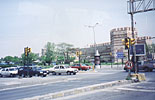 |
| First view of the walls of Constantinople, on the way in from the airport. |
The route to the hotel was so roundabout (because of one-way streets) that I am quite sure that if we had taken a taxi we would have thought the driver was cheating us. The traffic in Istanbul seemed chaotic, but not so much so as Athens, and no worse than Paris. There seemed fewer motorbikes than in Athens. Another contrast with Athens was that in Athens, most people seemed to use cell-phones, whereas in Istanbul there was a line-up outside just about every fixed phone booth. Even so, we saw more cell phones in use than we probably would have at home in Canada.
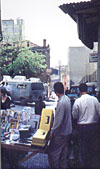 | 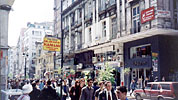 |
| Contrasting streets in Istanbul. (Above) Istiklal Caddesi (the red line on the map above from Taksim Square to Galatasary Tower). | |
| (Left) A street 2 blocks away parallel to Istiklal, where we found the shop with string. Galatasaray tower very faint in the centre background | |
At the hotel, the Reception told us where we might be able to buy some string to fix the suitcase handle. She gave us a little map, but following it was not as easy as it seemed, and we went off Taksim Square (top of the map) in slightly the wrong direction, winding up in a rather dingy area full of shops selling nothing but car parts. A couple of times passersby tried to help us, but didn't speak English. Finally, one stopped who did, and put us on the right road. We ought to have walked down Istiklal Caddesi (Street), which is mainly a pedestrian street with a tramline down the middle, full of people, many of them tourists. It used to be where there were many rich houses in Ottoman times, and toward to southern end there are still several Embassies. Police cars patrol slowly up and down the tramline.
On both sides of Istiklal the small side-streets have many shops of different kinds, in contrast to where we had been walking, where all the shops would sell one kind of thing, and then the next region all would sell another kind of thing. However, none of the shops that looked promising actually sold string. Finally, on a street parallel to Istiklal a couple of blocks on the other side from where we had been, we found the hardware store that sold string.
The string shop seemed to come from another world. The first impression was of an Ali Baba's cave. It was dark, with a small counter at one end, where three or four men were chatting. All around the walls, things were hanging or were piled on small shelves or little tables. We didn't see string, so we asked, with appropriate hand gestures. The shopkeeper pointed out a plastic bag hanging on the wall, containing eight balls of string. It was sealed, and we didn't want more than one ball, but when we hesitated, he tore open the bag and gave me one. It cost 750,000 Lira (about $1.80 Cdn or $1.25 US). The whole thing was very friendly, although we had felt a bit nervous to begin with, in such an unfamiliar place with a language whose words sounded and looked so strange.
After getting the string, we wandered around the little streets around Istiklal Caddesi. One sight that I have never seen elsewhere was a panel of miniature carpets displayed in the way postcards are often displayed. We were to find that this is very common in the parts of Turkey we visited--we actually bought some later at the Grand Bazaar. They make nice table decorations for putting things on.
Having mended the suitcase handle with the string, we attended the inaugural meeting of the Globus tour group, at which we met Ahmet Is.c.imen. He said he hoped that the roads would not have been washed out in areas of Turkey that had been subject to very recent heavy rains and flooding. Following that, we had dinner, sharing a table with a couple we had met on the Globus tour in Greece, and again in Fira when they had come ashore from a cruise ship.
 |
| The Northwest walls of Constantinople |
This day was spent on a bus tour of the European side of Istanbul. First we went around the outer walls of Constantinople, which were never breached by the Turks. Looking at what remains in good condition, one can see why. But there are several sections with new cracks in them from the 1999 earthquake, and some stabilisation work is needed (and being done). Twice, in the 13th and 15th centuries Constantinople was taken by attackers (Crusaders and Turks, respectively), but both times it was the sea defences that failed.
After circumnavigating old Constantinople, we went to the area at the tip of the peninsula (at the bottom of the map above) where many of the historical and archeological sites cluster.
 | 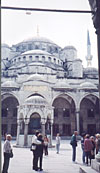 |
| (Left) Obelisk from the time of Cleopatra. The corroded 17th c one in the background. (Right) The inner court of Blue Mosque, with the fountain in front, in which the faithful wash before praying. | |
First we went to the Hippodrome. There is nothing of the stadium left, except an empty park space in which Ahmet pointed out the location of the long racetrack. This in Roman and Byzantine times was where chariot races were held that were the focus of the various political factions that vied for supremacy in the city. In the middle of what was the racetrack are two obelisks, one brought from Egypt that was put up around the time of Cleopatra, and one installed in the 17th century. The old one looks brand new, whereas the newer one is greatly corroded. According to Ahmet, the bronze feet on which the old obelisk stands are original, though the stand itself is not. The obelisk stand is in a pit perhaps 2 m deep, the bottom of which is at the original level of the Hippodrome track.
 |  |
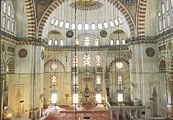 Inside
the Blue Mosque. (Top left) The
main dome. (Top right) The
floor. Each panel is for one person praying. Note the rich stained glass windows,
as in a church. (Lower left) a
postcard showing one of the side half domes and the rich ornamentation. Inside
the Blue Mosque. (Top left) The
main dome. (Top right) The
floor. Each panel is for one person praying. Note the rich stained glass windows,
as in a church. (Lower left) a
postcard showing one of the side half domes and the rich ornamentation. | |
Beside the Hippodrome is the Blue Mosque. It is enormous, with a capacity of 5000 on its floor for prayer, and another 5000 in each of the inner and outer courtyards. It was built in 1612, as an attempt to outdo the grandeur of the nearby Hagia Sofia.
In the picture of the inner court of the Blue Mosque, you can see a rod crossing the archway. Most of the arches have such a rod, which is to stabilise the arch against earthquakes. These rods are not modern, but were a part of the original construction.
Since the Blue Mosque is a working Mosque, you have to remove your shoes before entering, and put them in a bag that you carry with you (you leave by a different door). The outside gives very little clue as to what you see when you enter. Many people give a gasp of surprise and awe, both at the magnificent size and at the dramatic ornamentation. If you are a Moslem man, you are quite at liberty to go onto the main floor and pray (women pray in separate areas). The tourist public stays along one side of the floor, and is allowed in any time no service going on.
Mosques have no prescribed shape, as we were to see during out tour. Unlike a Western church, which conventionally has a floor plan based on a cross, a mosque is just a meeting place for prayer. But most mosques we saw seemed to be based on the Byzantine domed church shape. They are, however, uniquely identifiable by the existence of at least one minaret, from which the muezzin calls the faithful to prayer. A richer mosque may have more than one minaret, but that depends on the wealth and generosity of the congregation, more than anything else. When the Hagia Sofia was converted by the Turks from a church into a mosque, it was given four minarets. It was therefore necessary that the Blue Mosque should have six, and it is the only mosque to have so many.
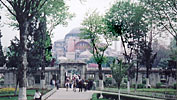 | 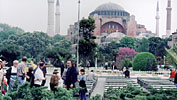 |
| Two views of the approach to the Hagia Sofia from the Blue Mosque. Our guide, Ahmet Is.c.imen is in the middle of the right-hand picture. | |
The Hagia Sofia is almost exactly 1100 years older than the Blue Mosque. It was built by Justinian starting in 532 AD. When the Turks captured Constantinople in 1497, the soldiers started out to destroy everything Christian, but the sultan was so impressed by the majesty of the the church that he forbade any further desecration. He turned it into a mosque, which it remained until Kemal Ataturk decided it was the heritage of all mankind rather than just of Islam, and made it into a museum around 1930.
Hagia Sofia creates a very different impression than the Blue Mosque. When one enters the Blue Mosque, the impression is of magnificence and opulence. In the Hagia Sofia, it is of spirituality. After seeing it, the Blue Mosque seems somehow pretentious, almost tawdry in its opulence, substituting glamour for beauty like a Hollywood starlet. But spiritual or not, the Hagia Sofia is breathtaking when one enters it.
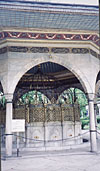 | 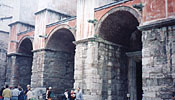 | 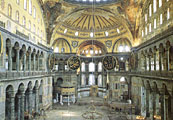 | 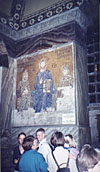 |
| Hagia Sofia. (Left) The washing fountain at the entrance. (Middle left) The entrance to the Hagia Sofia. (Middle right) A postcard of the interior, seen from the first gallery (the women's area when it was a mosque). (Right) A mosaic of Christ flanked by the Emperor Justinian and his mother, St. Helena in the part the Turks allowed to the Christians. | |||
We did not see the interior of the dome the way it is shown in the postcard, because a major restoration work is in progress, and a quarter of the dome is filled with scaffolding (an impressive construction in itself). It is interesting that the Turks reserved the gallery you see on the right of the interior picture above for use as a church, leaving several mosaics, which, with their depictions of people, were presumably sacreligious to the Moslems. Most of the mosaics have been considerably damaged over the nearly 1500 years since the church was built, but what is left is in several cases quite beautiful. The gold is real gold under glass.
Speaking of glass, the walls of the Hagia Sofia have many embedded things that look like dumbbells about 15 cm long. These turn out to be earthquake early-warning devices. If you are in the church and hear one or two break, you run, in case the church falls in on you. Many of them are actually cracked, presumably by past earthquakes, and nowadays the glass "seismic fuses" are functionally replaced by electronic strain guages that sound an alarm if they sense something. The dome did fall in shortly after it was built, but it was quickly rebuilt better, and it hasn't fallen in since, so I guess there wasn't much danger when we were there.
I went back into the Hagia Sofia by myself two weeks later, at the end of the tour, and the experience was quite different in the empty building. But that story will wait until the appropriate place in this diary.
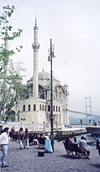 |  |  |
| By the Bosphorus. (Left) A rather pretty mosque. (Centre) The high bridge to Asia Minor. We crossed it the next day. (Right) The waterfront along the Bosphorus, looking toward the Golden Horn in the far distance. | ||
From the Hagia Sofia, we were taken for lunch to an area near the high bridge over the Bosphorus, where there are many restaurants of all different classes and prices. It was quite crowded, but there was lots of room nevertheless. You can see many of the diners in the middle picture with the high bridge. We had a bad experience there, the only time this happened in Turkey. We ordered a meal for which we thought the total cost should have been L5,500,000, but we were charged 8,000,000. The bill was, of course, undecipherable, and we couldn't argue so we paid what they asked. We checked with Ahmet, our guide, when we found him at another restaurant, and he agreed that we had been cheated, but there wasn't anything we could do about it. (We had other experiences of a completely opposite character over the next two weeks. This was an isolated incident, but a bit off-putting when it happened, so early in our Turkish experience.)
 | 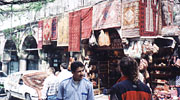 |
| Grand Bazaar: (Left) One of the main entrances. (Above) Carpet selling on a street outside the Bazaar. There were many more inside, not to mention elsewhere in Turkey. |
After lunch, we went back to the old city, to visit the Grand Bazaar. This is a sort of covered village of shops, with streets criss-crossing on a rectangular, but irregular, grid. There are areas in which most of the shops sell gold and jewellery, areas for leather good, areas for ceramics, areas for (of course) carpets, areas for housewares, etc. etc.
Before we went in, Ahmet told us how to bargain,. and what to expect. This is worth a little explanation. In a bazaar, you do not expect to pay the asking price, but you should make a counter-offer that is not insultingly low. After a couple of interchanges, you settle on a price that is about 60%-70% of the asking price, and both parties are happy. This is not what is done in ordinary shops. There you do not bargain by making a counter-offer. You may accept the asking price, or you may ask if that is the best price the seller can give you. You may suggest some little extra might be thrown in at the original price, or something like that, but it is a bit discourteous to bargain in the way you are expected to do in a bazaar.
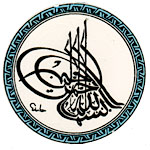
 Inside
the bazaar, most of the shops have men outside extolling the virtues of their
wares, but not aggressively. We enquired about a beautiful small silk carpet about
1m x 60 cm, but the asking price was $400US. This being way out of our price range,
we didn't try to bargain him down, but just said it was too expensive. He tried
to get us to offer a price, but we didn't. However, at the other end of the price
range, we bought a couple of round tiles decorated with Arabic writing, about
15 cm in diameter. The asking price was L3,000,000 each, and we settled for L4,000,000
for two, which you see on either side of this paragraph. Both designs are popular.
You see them in textiles and on many different ceramics. The one on the right
is called, I believe "The Thread of Life."
Inside
the bazaar, most of the shops have men outside extolling the virtues of their
wares, but not aggressively. We enquired about a beautiful small silk carpet about
1m x 60 cm, but the asking price was $400US. This being way out of our price range,
we didn't try to bargain him down, but just said it was too expensive. He tried
to get us to offer a price, but we didn't. However, at the other end of the price
range, we bought a couple of round tiles decorated with Arabic writing, about
15 cm in diameter. The asking price was L3,000,000 each, and we settled for L4,000,000
for two, which you see on either side of this paragraph. Both designs are popular.
You see them in textiles and on many different ceramics. The one on the right
is called, I believe "The Thread of Life."
 |
| One of the mini-carpets we bought. This one is 15cm long. |
We had a similar bargaining experience a little later in our visit to the Grand Bazaar. There was one of the displays of miniature carpets, but these were of various shapes and sizes, not just postcard size, but also bookmark size like a miniature runner, and several slightly larger sizes. We selected a group of them with a total marked price of L5,000,000, and bargained for L3,500,000. But instead of giving us change for a five-million lire note, he threw in two more carpets with an asking price of L2,500,000. They are quite nice, and we now use them at home, under display objects.
The picture at the left is scanned directly off one of the carpets, not from a photograph. We now use it under a replica of an extraordinary early Bronze Age casting of a group of deer we bought at the Archaeological Museum in Ankara.
All this time, my stomach had been a little unhappy with a mild nausea and cramp, so I was happy to get back to the hotel. We did not take dinner, but bought a small bottle of wine and some bread and a banana, which was a nice way to finish the day.
If you want more of Istanbul, without the intervening tour, click here.